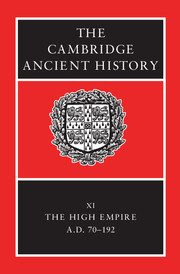Book contents
- Frontmatter
- PART I NARRATIVE
- PART II GOVERNMENT AND CIVIL ADMINISTRATION
- 4 The emperor and his advisers
- 5 Emperor, Senate and magistrates
- 6 The growth of administrative posts
- 7 Provincial administration and finance
- PART III THE EMPIRE
- PART IV ROME, ITALY AND THE PROVINCES
- PART Va ECONOMY AND SOCIETY
- PART Vb ART AND CULTURE
- Chronological Table
- BIBLIOGRAPHY
- Index
- 1 The Roman world in the time of Marcus Aurelius
- 7 The Danube provinces
- References
6 - The growth of administrative posts
from PART II - GOVERNMENT AND CIVIL ADMINISTRATION
Published online by Cambridge University Press: 28 March 2008
- Frontmatter
- PART I NARRATIVE
- PART II GOVERNMENT AND CIVIL ADMINISTRATION
- 4 The emperor and his advisers
- 5 Emperor, Senate and magistrates
- 6 The growth of administrative posts
- 7 Provincial administration and finance
- PART III THE EMPIRE
- PART IV ROME, ITALY AND THE PROVINCES
- PART Va ECONOMY AND SOCIETY
- PART Vb ART AND CULTURE
- Chronological Table
- BIBLIOGRAPHY
- Index
- 1 The Roman world in the time of Marcus Aurelius
- 7 The Danube provinces
- References
Summary
Throughout the imperial period the structure of the senatorial career and the numbers of posts which senators might hold remained essentially what had been established by Augustus. Any changes which were made were relatively slight. Similarly, the increasingly common employment of men of non-senatorial origin in administrative posts had already been introduced in Augustus' reforms. This is well exemplified by the posts of the praefectus Aegypti, the two praefecti for the grain supply and the fire brigade in the city of Rome, together with the financial procurators, who performed various duties in both the imperial and public provinces. Further examples are the imperial freedmen and slaves, who, after the death of Augustus, could provide information on the financial health of the aerarium and the various imperial treasuries, for which they were responsible, as well as for outstanding taxes. Yet Augustus had only laid the foundations for this new style of government, which was largely alien to the Republic. It would not have been possible to foresee how the administration would expand and develop. In his biography of the first princes, Suetonius typically makes no reference to equestrian posts – that is, the new officials whose appointment foreshadowed what was to come – although he very carefully notes the new senatorial posts created by Augustus.
The degree and speed at which the non-senatorial areas of administration developed alongside those controlled by senators is still not entirely clear. The main reasons for this are, on the one hand, the way in which information has been passed down to us and, on the other, the fact that the duties of these posts were probably often not constituted through formal enactments, in particular those which would be recorded in the Senate.
- Type
- Chapter
- Information
- The Cambridge Ancient History , pp. 238 - 265Publisher: Cambridge University PressPrint publication year: 2000
References
- 3
- Cited by

